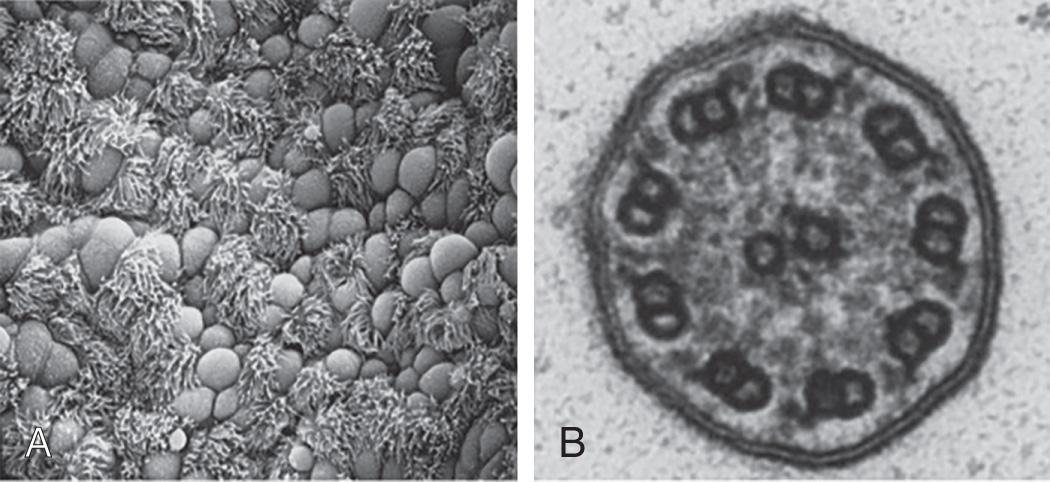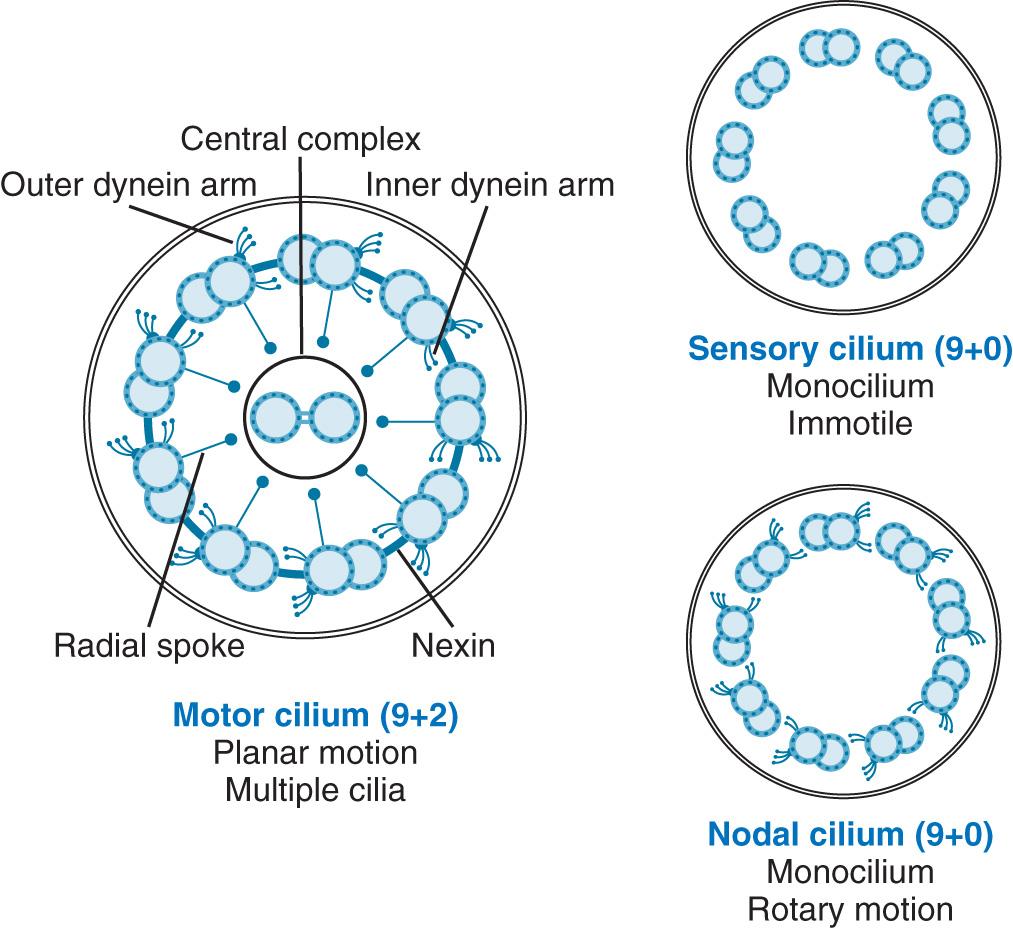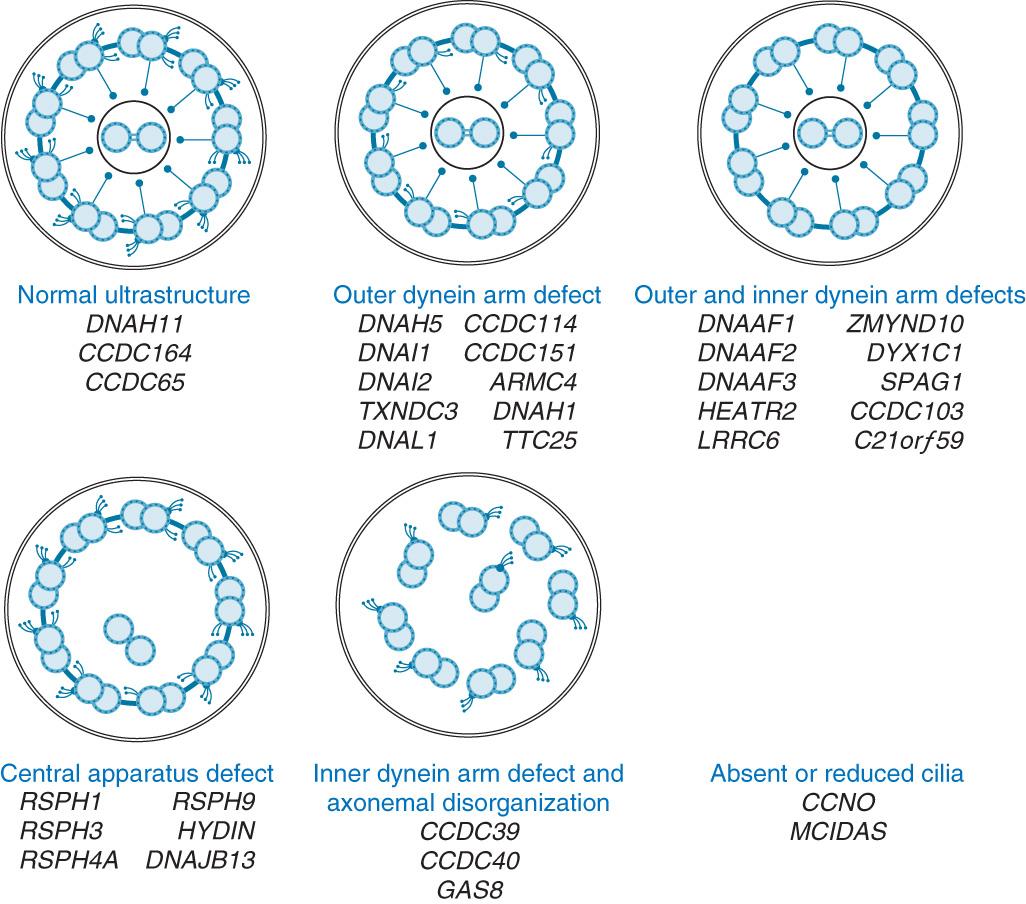Physical Address
304 North Cardinal St.
Dorchester Center, MA 02124
Primary ciliary dyskinesia (PCD) is an inherited disorder characterized by impaired ciliary function leading to diverse clinical manifestations, including chronic sinopulmonary disease, persistent middle ear effusions, laterality defects, and infertility. The estimated frequency of PCD is 1 in 12,000 to 1 in 20,000 live births, but its prevalence in children with repeated respiratory infections has been estimated to be as high as 5%.
Three types of cilia exist in humans: motile cilia, primary (sensory) cilia, and nodal cilia. The respiratory epithelium in the nasopharynx, middle ear, paranasal sinuses, and larger airways are lined by a ciliated, pseudostratified columnar epithelium that is essential for mucociliary clearance. A mature ciliated epithelial cell has approximately 200 uniform motile cilia , hair-like organelles that move fluids, mucus, and inhaled particulates vectorially from conducting airways ( Fig. 433.1 ). Motor cilia are anatomically and functionally oriented in the same direction, moving with intracellular and intercellular synchrony. Anchored by a basal body to the apical cytoplasm and extending from the apical cell surface into the airway lumen, each cilium is a complex, specialized structure, composed of hundreds of proteins. It contains a cylinder of microtubule doublets organized around a central pair of microtubules ( Fig. 433.2 ), leading to the characteristic “9+2” arrangement seen on cross-sectional views on transmission electron microscopy. A membrane continuous with the plasma membrane covers the central fibrillar structure, or axoneme. The ciliary axoneme is highly conserved across species, and the structural elements of simple algal flagella and the mammalian cilium are similar. Attached to the A microtubules as distinct inner and outer dynein arms, multiple adenosine triphosphatases, called dyneins, serve as motors of the cilium and promote microtubule sliding, which is converted into bending. Each dynein arm is a multimer with heavy, intermediate, and light chains, with each dynein protein encoded by a different gene. The inner dynein arm influences the bend shape of the cilium, whereas the outer dynein arm controls beat force and frequency. The inner dynein arm and radial spokes are also parts of the dynein regulatory complex, a key regulator of motor activity. Nexin links connecting adjacent outer microtubular doublets limit the degree of sliding between microtubules. All these structures lead to synchronized ciliary beating, resulting in a ciliary stroke and coordinated beating at a frequency constant throughout the airway, 8-20 beats/sec, but can be negatively affected by several factors, such as anesthetics and dehydration. Alternatively, beat frequency may be accelerated by exposure to irritants or bioactive molecules, including β-adrenergic agents, acetylcholine, and serotonin. Cilia beat frequency can be increased through the activity of nitric oxide synthases that are localized in the apical cytoplasm. The coordinated wavelike pattern of ciliary motion has important functions in fluid and cell movement, and any disturbance in the precise, orchestrated movement of the cilia can lead to disease.


Primary (sensory) cilia are solitary organelles present during interphase on most cell types. These cilia lack a central microtubule doublet and dynein arms, thus creating a “9+0” arrangement and leaving them immotile (see Fig. 433.2 ). These structures were once considered nonfunctional vestigial remnants, but primary cilia are important signaling organelles that sense the extracellular environment. They are mechanoreceptors, chemosensors, and osmosensors and, in specialized cases, detect changes in light, temperature, and gravity. Defects (ciliopathies) are linked to wide-ranging pediatric conditions, such as various polycystic kidney diseases, nephronophthisis, Bardet-Biedl syndrome, Meckel-Gruber syndrome, Joubert syndrome, Alström syndrome, Ellis-van Creveld syndrome, and Jeune thoracic dystrophy.
The third type of cilia exists only during a brief period of embryonic development. Nodal cilia have a “9+0” microtubule arrangement similar to that of primary cilia, but they exhibit a whirling, rotational movement (see Fig. 433.2 ), resulting in leftward flow of extracellular fluid that establishes body sidedness. Nodal cilia defects result in body orientation abnormalities, such as situs inversus totalis , situs ambiguus , and heterotaxy associated with congenital heart disease, asplenia, and polysplenia (see Chapter 458.11 ).
PCD typically has autosomal recessive patterns of inheritance, although X-linked inheritance has been reported. PCD is a genetically heterogeneous disorder involving multiple genes; mutations in any protein that is involved in ciliary assembly, structure, or function could theoretically cause disease. Early linkage studies showed substantial locus heterogeneity, which made correlations between ciliary defects and the underlying mutations difficult. Mutations in 40 different genes have been linked to PCD ( Fig. 433.3 ), including those that encode proteins integral to the outer dynein arm: DNAH5, DNAH1, DNAI1, DNAL1, DNAI2, TXNDC3, CCDC114, CCDC151, ARMC4 , and TTC25 ; dynein regulatory complex and nexin components: CCDC39, CCDC40 , and GAS8 ; and radial spoke and central apparatus proteins: RSPH1, RSPH3, RSPH4A, RSPH9, HYDIN , and DNAJB13 . Mutations in genes coding several cytoplasmic proteins, not part of the cilia axoneme, have also been identified and appear to have roles in cilia assembly or protein transport, including: HEATR2, DNAAF1, DNAAF2, DNAAF3, CCDC103, LRRC6, DYX1C1, SPAG1, ZMYND10 , and an open reading frame sequence, C21orf59. Not all patients with PCD have an identifiable genetic mutation.

The genetic bases of ciliopathies have yielded greater understanding of genotype-phenotype relationships in PCD. Mutations in nexin-dynein regulatory complex proteins create inconsistent ultrastructural abnormalities characterized by absent inner dynein arms in all axonemes, but misplaced radial spokes and microtubular disorganization in only some cilia. A cross-sectional study showed that children who had microtubular disorganization, primarily due to biallelic mutations in CCDC39 or CCDC40 , had more severe lung disease. In contrast, patients with mutations in RSPH1 appear to have milder respiratory phenotypes.
Become a Clinical Tree membership for Full access and enjoy Unlimited articles
If you are a member. Log in here